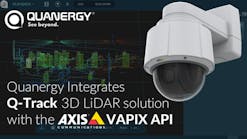Once upon a time, a video management system (VMS) was something truly innovative in the world of video surveillance. Being able to have easy access to video, including from remote locations, was something that offered both more security as well as cost savings, with the idea that one person in a control booth could virtually patrol several areas at once and dispatch security personnel as needed.
That novelty has worn off to the point where VMS is more and more of a commodity and many customers are asking: “That’s fine. But what else do you have?” In line with that, many want analytics features, such as facial recognition and license plate recognition (LPR). In addition, rather than have to go to various vendors for different analytics solutions, they want them to come built into the software, with the idea that they can be turned on as needed, depending upon security needs.
The saying, “Everything old is new again,” doesn’t really apply to the world of video surveillance. It would be more like: “Everything new quickly becomes old,” particularly as security needs continue to increase, and along with that the need for automated and intelligent features.
Are you showing your customers the value?
One of the drivers here is definitely economic. If VMS gave customers a sense of just how much more security they could get through better software, and how that in turn could reduce overall personnel costs, analytics is giving them an even better idea of how the security process can be further streamlined. LPR, for example, can not only read plates much faster than the human eye, but with the right analytics in place, it can tell you if the car is stolen or is linked to a terrorist suspect. There will always be a place in security for the human element. Someone, after all, has to receive that alert about a stolen car, as well as coordinate emergency responses. To that end, there are certain things only people can do, others that only the technology can accomplish.
Analytics is designed to make the whole security process easier, but there are also other factors that drive its increased adoption in many different arenas. Tough economic times have resulted in spikes in crime worldwide, and this has created an increased need to provide more security for people in all kinds of situations and protect assets of all kinds. There are many real world applications for analytics that take place every day and make clear how necessary this technology has become for security personnel and law enforcement.
Facial recognition systems, for example, now help keep any of a number of public and private areas safer—including stadiums, corporations, train stations and airports, as well as many different divisions of government. The ability of such a system to spot a wanted felon and automatically alert appropriate personnel so they can take preventive action is a major step forward for security and law enforcement. At the same time, with shrinking budgets and less financial resources to expand security and law enforcement staff, the ability of such technology to fill the gaps is also crucial.
As VMS becomes increasingly commoditized and analytics comes more and more into its own, the ultimate beneficiaries will be the end users, both in terms of cost as well as overall security. Here’s what you need to know:
Megapixel Cameras Enable the Move to Analytics
Megapixel cameras have done much to help increase the use of analytics features in the video surveillance industry. There are two essential features of megapixel cameras that make that possible: ultra high resolution of images and forensic inspection. The higher resolution quality allows for clearer identification of images, which is crucial in analytics. Forensic inspection is related to the fact that with megapixel cameras you can zoom in on images with very little loss in clarity. Analytics such as facial and LPR depend on being able to quickly and precisely identify images, so this forensic feature is crucial for overall success.
At the Edge and Embedded in the System
Once one has decided to purchase some form of a video analytics solution, the question often becomes: should the analytics come built into the software or would it be better to have them at the edge, that is, in the camera? The answer to that depends upon the purpose of the application. For instance, in a situation in which the user needs video analytics to know if a person has trespassed onto the rooftop of a high-security building, it will generally suffice to have a system that can distinguish between a human form and something else, like a bird. If the only need is to know whether it’s a person or a bird (or some other kind of animal) on the roof, then having the analytics built in at the edge, right into the cameras, will suffice because there is not a need to cross reference a database to make any sort of identification.
However, extending this same situation a bit, what if security spots a person in the parking garage at an unusually late hour and wants to try to identify the individual via facial recognition? To do so, security personnel may have to cross reference various databases, in which case having a system where the analytics are built into the software of the system will be most beneficial. Other situations where that also makes sense involve container recognition, traffic monitoring, and license plate recognition (LPR). In these various applications, the need to share and cross reference information is crucial, so that merely having the analytics at the edge is not sufficient.
Adoption: One-Stop Shopping or Buying Down the Line?
There are often questions as well about the adoption process related to video analytics. In some cases, a user may not have a pressing need for video analytics and simply deals with their immediate security requirements and opts for basic VMS features, with the idea that down the line, if they need analytics, they can always bring in another vendor who specializes in that. The problem that many end users have found out from hard experience is that analytics is not a simple add-on and that dealing with a different vendor can be hugely disruptive to their whole video surveillance system.
Security professionals are all too familiar with the sort of Murphy’s Law that comes into play when adding new software programs to a system and if something can go wrong, it often does. As a point of comparison, changing to a new video management system is as challenging in its own way as changing one’s whole system from Windows to Mac or Linux. The learning curve for the operators and administrators, including intensive, costly trainings and system downtime can quickly become overwhelming. The decision for the video management and analytics platform has to be very carefully evaluated. Users should consider systems that utilize intelligence at the edge but also have the built-in capabilities of all other analytics. That way, modules can be switched on as they are needed while the staff has the convenience of the same well known management platform.
True Intelligence and Open Architecture
A truly intelligent system will be able to analyze an event in depth and make or propose a decision regarding that. For instance, the ability to detect motion does not by itself make a system truly intelligent. As with our earlier example, the ability to distinguish between a human form and a bird, or to send an alert if a car is broken down on the highway, or to spot a package that has been left on a subway platform and notify relevant personnel—those are characteristic of a system with real intelligence. To that extent, end users need to question security professionals about the criteria that they use to define truly intelligent video analytics. In the simplest sense, the smarter your algorithms, the more accurate your analytics will be.
In regards to architecture, it is not enough that a system provides video analytics, but interfaces need to be in place so that it communicates with other security applications like fire and burglar alarms and access control. This makes is possible to cross-verify information or provide video information for each system where an alert has been triggered.
For example, in the event that a back door alarm sounds, security personnel should not only be able to view who triggered the alarm, but know if it is someone who has a history of such activity. To that end, the alarm must interface with a facial recognition or face capture system that can provide the information. An access control system that employs card swipe should have that same capability. If, for instance, an employee is swiping their card after hours, the system should be able to provide video immediately so that the system can verify that it is the employee in question using the card (and not someone else or perhaps a case of forced entry). These interfaces ensure an optimal use of video analytics in relation to the whole security system.
The Road Ahead
Both the public and private sector have an increasing need for video analytics solutions. This includes banks, retail, property and building management firms, government agencies, law enforcement and counterterrorism units. However, it is only with the smart combination of all involved security processes, including non video related information sources (such as access control and asset management) that the user can reap optimal benefits. Video analytics supports the decision process, but only the cross-verification of events with other devices and databases creates a truly smart system.
For cash-strapped law enforcement agencies, such a system can reduce the need for more personnel as well as become an important crime fighting partner and an aid in traffic safety and revenue generation by spotting more offenders (whether it be running red lights, illegal turns, etc.). Counterterrorism units simply demand the latest technical innovations available, including video analytics, to more effectively spot and reduce potential threats.
As the role of video analytics increases in importance and adoption, security sales forces and integration specialists must be knowledge experts and be prepared to custom fit solutions for their customers because this is one arena in which one size definitely does not fit all. In addition, those currently purchasing a VMS should seriously evaluate their long term needs, as to whether it is likely that analytics will sooner than later be a part of their needs. If so, one should consider overall time and financial expenditures to add on analytics after the fact. In a world where VMS is increasingly becoming a commodity, and analytics a necessity, the decision to include it is becoming more and more clear cut for many customers.



